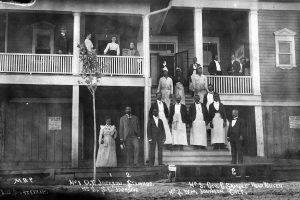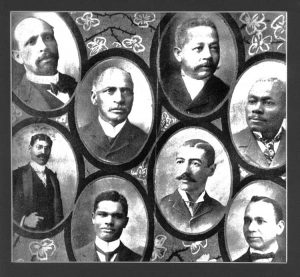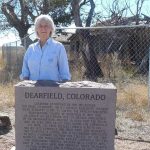Three Illustrious African-American Pioneers of Boulder
01 Dec 2017
George Morrison, O.T. Jackson and Junius Lewis
By Kerstin Lieff George Morrison, credited as one of the main influences on the development of jazz, is one of the more illustrious African-Americans of Boulder. At the age of 9, he was already a prodigy on the violin. According to the Daily Camera, he and his brother “slid up and down Boulder County’s dangerous canyon roads in a horse and buggy, playing in any kind of building they could find.” Those buildings would have been in the mining camps of Salina, Sunset, Gold Hill and Sugarloaf. “People came from miles around and danced all night long, from 7 until 8 the next morning,” he said of his early career. By 1917, his 12-piece Morrison Brothers’ String Band had become known in Denver, Chicago and New York, and included as singer Hattie McDaniel, the first African-American artist to win an Academy Award for her role as Mammy in Gone With the Wind. In 1919, the band became one of the first recording stars of Columbia Records, and in the 1930s, Morrison’s hosting of leading jazz musicians made Denver the acclaimed jazz center west of Kansas City.I used to crawl under my father’s and mother’s bed where he kept his fiddle. I’d open up the old wooden case and the old flour bag he’d wrap it up in and I’d take the bow and draw it across the strings. … A few years later, I began to make my own violins. I took a corn stalk and hollowed it out. With a knife, I cut the stalk in four strips, and then I’d get me a little piece of wood and put some cord strings on there. I’d tighten them up by driving nails up in the head and tighten them up just as tight as I could by hand. I would go out and get me a little stick from a pussy willow tree and bend it. That would be the bow. Then I’d rub charcoal on the strings—it took the place of the rosin—to produce a sound. I was about five years old when I was doing that. Later, I made my violins out of cigar boxes. —George MorrisonDescribed as “a beaming five-foot-four portly teddy bear whose sweetness outshone the sadness,” Morrison lived a life that held great fame and equal heartbreak. His greatest regret, he told the Daily Camera in 1970, was that he had always wanted to be a concert violinist but was barred from playing in the symphony orchestra because he was African-American. George Morrison counted Jelly Roll Morton, Scott Joplin, Duke Ellington, Nat King Cole and Count Basie as friends. Morrison lived several blocks to the north of the Little Rectangle, and next door to him, at 2228 Pine St., lived another illustrious Boulder man, Oliver Toussaint Jackson. O.T. Jackson, an entrepreneur whose family had been free for three generations, was once named “one of Boulder’s leading businessmen.” He began his career in 1894 as the proprietor of the Stillman Hotel and Café, “one of Boulder’s premier dining establishments,” located where The Kitchen restaurant now stands. The Daily Camera on Dec. 24, 1894, advertised: “Jackson will make a memorable event of the Stillman Hotel Christmas dinner, saying he has genuine opossum among other delicacies for his guests.” In 1897, Boulder, wanting to put its name on the map as a destination resort location, raised $20,000 to build a Chautauqua in response to the Texas Board of Education’s desire to offer its teachers a summer learning program. Upon its completion, the city hired a “well known and well regarded restaurateur” to manage its Dining Hall—O.T. Jackson. At its inaugural, an estimated 5,000 people visited, and were served a remarkable dinner that included a delicacy, strawberries with cream.

Several of Fort Worth’s women of “gentility” complained that Jackson’s staff created “an element of discord” at the dining hall, and that, anyway, a popular thing was to hire college students. The Chautauqua brochures of 1900 advertised 12 college women and three young men as staff, citing “no obsequious waiters.” O.T. Jackson later served for 20 years as messenger for Colorado’s governors, both Republican and Democratic, except for the KKK-picked Republican Clarence Morley from 1924-27.Inspired by Booker T. Washington’s 1901 autobiography, Up From Slavery, Jackson became increasingly interested in creating a self-supporting farming community for African-Americans. In 1910, he founded Dearfield, named so “because it will be so dear to us.” The colony sat on the plains of the South Platte River 30 miles east of Greeley. At its height in 1917, 60 African-American families had settled there on more than 20,000 acres. The town had a school, several churches, two groceries, a gas station and a post office. George Morrison built a dance hall there and the town became a popular recreation spot for Denver’s African-American population. Dearfield is now listed on the National Register of Historic Places. And what of Junius Lewis? At the age of 54, he came to Boulder and worked for the Golden Chest Mining Company, and, according to the Trans-American Title Insurance Company, he become its owner a few years later. Although accounts are vague of how much gold was actually mined, it appears his mines did yield substantial quantities of ore during the 12-year period of his ownership. Sadly, an Irishwoman from Denver, arguing against the “negro ownership,” fought him for claims to his mine until he was well into his 80s.

Escaped from slavery at age 20, Junius Lewis ran more than 300 miles before being caught by the Confederate Army. Considered “stolen property,” he was conscripted—better said, imprisoned—to serve for the duration of the war. He witnessed the surrender of General Lee to General Grant at Appomattox, Va., on April 9, 1865. As owner of the Golden Chest Mining Co., his life was plagued by a certain Delia McMenamin, who fought him in court for over 20 years, trying to “reclaim the mines” for white stockholders. For several years after Lewis began the venture, all members of the corporation were African-American, and at what point white stockholders invested in the company is not clear. Reported to have been in at least one gun-slinging episode, McMenamin arrived at the mine one day with a bag of salt and a frying pan, hoping therewith to claim ownership, even though there is no clear link between her and the Golden Chest Mining Co. Court statements appear to be direct attempts by her lawyer to appeal to the court’s racial biases. In all cases, court decisions favored Lewis.These are three of the many citizens who helped establish our fledgling city. But their histories whisper something more. They were men who lived an ongoing struggle against adversity and discrimination, yet they were men whose marks remain—men, too, who did not let circumstances stop them. George Morrison said it well:
I shall only pass this way but once
So I’ll do the best I can
By leaving my footprints upon the sand
As a guiding path for my fellow man.
Author’s note
I met Margaret Picher in a writers’ group six years ago. She was writing Nobody Knows: The History of Dearfield and the Early African Americans in Colorado. Over the course of our friendship I became privy to countless stories that astounded me, stories I’d never heard before. My children have African in their ancestry. Any knowledge of the heritage that is so often overlooked always interests me, so I finally asked Margaret if she would show me exactly where in Boulder her stories took place. She was more than obliging, and took me up Sugarloaf Mountain, over the Switzerland Trail, into Sunset and Salina, and then back into Boulder to “the Little Rectangle,” the neighborhood, bordered by 19th and 23rd streets, Canyon Boulevard (then Water Street) and both sides of Goss Street, where most African-Americans once lived.
—Kerstin Lieff
Kerstin Lieff (www.kerstinlieff.com) is a contributing writer for Boulder Magazine and Boulder County Home & Garden Magazine. Her book, Letters From Berlin, won the Colorado Book Award in 2013. She received her master’s degree in creative writing from Fairleigh Dickinson University and lives in Boulder.












